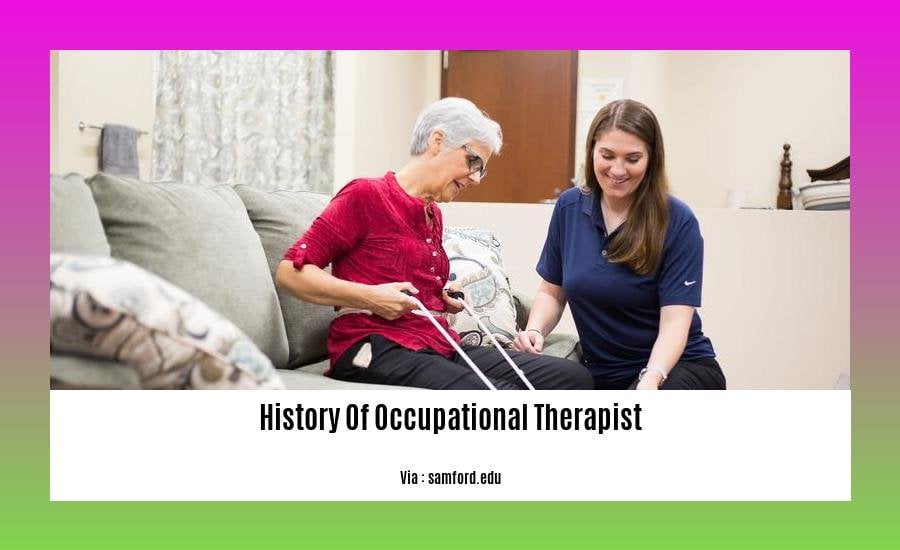Embark on a remarkable journey through the annals of occupational therapy as we unveil [A Century of Transformation: The History of Occupational Therapists]. Delve into the fascinating evolution of a profession dedicated to empowering individuals to live life to the fullest. Discover how occupational therapists have revolutionized healthcare, enabling people to overcome physical, cognitive, and psychosocial challenges through the power of purposeful activities and interventions. From its humble beginnings to its current status as a cornerstone of modern healthcare, prepare to be inspired by the stories of resilience, innovation, and unwavering commitment that have shaped the field of occupational therapy.
Key Takeaways:
The history of occupational therapy can be traced back to Ancient Greek times, with Asclepiades of Bithynia using activities to treat mental illness in Rome.
During the Age of Enlightenment, occupational therapy challenged the inhumane treatment of the mentally ill, emphasizing moral treatment and purposeful activities.
Arts and crafts gained popularity as a means to enhance function and well-being.
The term “occupational therapy” was coined by George Edward Barton, who established an arts and crafts workshop in New York.
History of Occupational Therapists

Have you ever wondered where occupational therapy came from? It’s a fascinating story that goes back thousands of years!
Ancient Times: A Holistic Approach
As far back as ancient Greece, healers like Asclepiades of Bithynia (124-40 BCE) were using activities like bathing, creative projects, and massages to treat people with mental illnesses. This marked the beginning of occupational therapy’s focus on using purposeful undertakings to promote mental well-being.
Age of Enlightenment: Challenging Cruel Practices
The 18th century saw a shift in attitudes toward people with mental illnesses. Instead of being locked away in asylums, they were encouraged to engage in meaningful activities that would help them recover. This paved the way for occupational therapy as a formal discipline.
19th Century: Moral Treatment and Arts & Crafts
The 19th century brought the rise of moral treatment, which focused on improving conditions in mental institutions. During this period, arts and crafts emerged as a popular form of occupational therapy, helping to improve patients’ cognitive, social, and motor skills.
20th Century: Occupational Therapy as a Defined Profession
In the early 20th century, occupational therapy gained recognition as a distinct profession. In 1917, the American Occupational Therapy Association (AOTA) was formed, and the first occupational therapy curriculum was established at the Boston School of Occupational Therapy.
World Wars and Beyond: Expanding the Scope of Occupational Therapy
Occupational therapy played a crucial role during both World Wars. Therapists helped wounded soldiers recover from physical and psychological injuries, enabling them to return to their daily lives. Post-war, occupational therapy became more widely accepted and was used in various settings, including hospitals, rehabilitation centers, and schools.
Modern Occupational Therapy: A Diverse and Dynamic Field
Today, occupational therapists work in a diverse range of healthcare, educational, and community-based settings, serving people of all ages with a wide variety of needs. Armed with a deep understanding of the mind-body-environment connection, they use evidence-based interventions to help individuals achieve their highest level of independence, engagement, and overall well-being.
Explore the journey of the revered Nathdwara temple from its origins to its current status as a sacred pilgrimage site for devotees worldwide-read the story.
Learn the engrossing story of OSHA’s inception and discover how it transformed occupational safety and health standards in the United States. Read the full history.
Occupational Therapy During Wars: Highlight the crucial role of occupational therapists in war efforts, providing rehabilitation and support to wounded soldiers.
In the midst of war’s devastating impact, a beacon of hope shines through the tireless efforts of occupational therapists (OTs). These dedicated professionals have played a pivotal role in mending the shattered lives of soldiers, both physically and mentally, throughout history.
A Healing Touch in the Trenches
During the horrors of World War I and World War II, OTs emerged as unsung heroes on the battlefields. Amidst the chaos and despair, they provided a lifeline of support to wounded soldiers, helping them navigate the arduous journey of recovery.
Occupational Restoration: The Path to Recovery
OTs employed a holistic approach, focusing not just on physical rehabilitation but also on restoring soldiers’ occupational roles. Through tailored interventions, they helped soldiers regain the skills and abilities needed to return to their daily lives and meaningful activities.
Beyond Rehabilitation: Addressing Psychological Wounds
The psychological impact of war is often overlooked, yet OTs recognized its profound effects on soldiers’ well-being. They employed creative and engaging activities to address psychological trauma, providing a safe space for soldiers to process their experiences and rebuild their emotional resilience.
Key Takeaways:
Battlefield Healers: OTs served as frontline healers, providing much-needed support to wounded soldiers during World Wars I and II.
Holistic Approach: Beyond physical rehabilitation, OTs focused on restoring soldiers’ occupational roles, empowering them to reclaim their sense of purpose and independence.
Psychological Care: OTs recognized the importance of addressing psychological trauma, employing creative activities to promote healing and resilience among soldiers.
Relevant Sources:
Professional Recognition and Growth: Discuss the establishment of occupational therapy associations and educational programs, leading to the formalization of the profession.

Formalizing the profession of occupational therapy involved establishing associations and educational programs, which laid the foundation for professional recognition and growth.
Associations:
– 1917: The National Society for the Promotion of Occupational Therapy (NSPOT) was founded, later becoming the American Occupational Therapy Association (AOTA).
– 1923: The British Association of Occupational Therapists (BAOT) was established.
Educational Programs:
– 1918: The first occupational therapy curriculum was established at the Philadelphia School of Occupational Therapy.
– 1922: The first occupational therapy degree program was offered at the University of Toronto.
– 1961: The American Medical Association (AMA) approved the Council on Medical Education’s report on the establishment of the occupational therapy profession.
Recognition:
– 1950: AOTA was granted affiliate status by the World Federation of Occupational Therapists (WFOT).
– 1952: WFOT was formally established, and AOTA became a founding member.
Contribution:
– Standardization: Associations helped standardize educational standards and professional practice.
– Advocacy: AOTA advocated for the recognition of occupational therapy as a distinct profession.
– Research: Associations supported research to advance the field.
– Collaboration: WFOT fostered international collaboration and shared knowledge.
Key Takeaways:
The establishment of associations like AOTA and BAOT provided a platform for promoting and unifying the profession.
Educational programs laid the foundation for formal training, ensuring the competence and expertise of occupational therapists.
AOTA’s advocacy efforts led to the recognition of occupational therapy as a distinct profession by the AMA.
WFOT’s establishment facilitated international collaboration and knowledge-sharing, advancing the profession globally.
References:
- http://www.aota.org/About-AOTA/News-Publications/podcasts/OT-History-101-Part-1.aspx
**Current Landscape and Future Directions: Provide an overview of the contemporary scope of occupational therapy practice and emerging trends shaping its future.**
Occupational therapy, rooted in the philosophy of occupation-based practice, is a dynamic field that empowers individuals to achieve their highest level of independence and quality of life through purposeful activities. In recent years, occupational therapy has undergone a significant transformation, broadening its scope and embracing innovative approaches to meet the evolving needs of diverse populations.
Contemporary Scope of Practice:
Holistic Approach: Occupational therapists adopt a holistic approach, considering the physical, cognitive, emotional, and social aspects of individuals when developing interventions.
Evidence-Based Practice: The profession emphasizes evidence-based practice, integrating research findings and clinical expertise to ensure effective interventions.
Client-Centered Care: Occupational therapists collaborate closely with clients to understand their goals, values, and preferences, tailoring interventions to meet their unique needs.
Interdisciplinary Collaboration: Occupational therapists work in interdisciplinary teams, partnering with healthcare professionals from various disciplines to provide comprehensive care.
Diverse Settings: Occupational therapists practice in a wide range of settings, including hospitals, clinics, schools, workplaces, and community-based organizations.
Emerging Trends Shaping the Future:
Telehealth: The use of telehealth platforms has enabled occupational therapists to provide remote care, expanding access to services for individuals in underserved areas.
Technology and Assistive Devices: Advancements in technology have led to the development of innovative assistive devices and software that enhance participation and independence.
Mental Health and Well-being: Occupational therapists are increasingly recognized for their role in promoting mental health and well-being through occupation-based interventions.
Health Promotion and Prevention: Occupational therapists are actively involved in health promotion and prevention initiatives, helping individuals adopt healthy habits and prevent injuries.
Global Impact: Occupational therapy is expanding globally, with occupational therapists working across borders to address the needs of diverse populations.
Key Takeaways:
Occupation-Based Practice: The philosophy of occupation-based practice remains the cornerstone of occupational therapy, emphasizing the importance of meaningful activities in promoting health and well-being.
Evidence-Based Practice: Occupational therapists are committed to using evidence-based interventions to ensure effective and client-centered care.
Collaboration and Teamwork: Occupational therapists work in interdisciplinary teams to provide comprehensive care, collaborating with other healthcare professionals to achieve optimal outcomes for clients.
Adapting to Changing Needs: Occupational therapy is constantly evolving to meet the changing needs of society, embracing emerging trends and technologies to enhance the quality of life for individuals across the lifespan.
Relevant URL Sources:
[1] https://www.aota.org/About-Occupational-Therapy/Professionals/What-is-Occupational-Therapy.aspx
[2] https://pubmed.ncbi.nlm.nih.gov/32356478/
FAQ
Q1: When did occupational therapy originate?
A1: The foundations of occupational therapy can be traced back to ancient times, with figures like Asclepiades of Bithynia incorporating activities in the treatment of mental illness as early as the 1st century BCE.
Q2: How did occupational therapy evolve during the Age of Enlightenment?
A2: During the Age of Enlightenment, occupational therapy emerged as a challenge to the prevailing inhumane treatment of individuals with mental illness. It advocated for moral treatment and the use of purposeful activities to promote well-being.
Q3: What role did occupational therapy play in the military?
A3: Occupational therapy played a crucial role in addressing the psychological trauma and rehabilitation of injured soldiers during World War I and World War II. It supported their occupational and physical restoration, facilitating their reintegration into society.
Q4: Who coined the term “occupational therapy”?
A4: The term “occupational therapy” was first coined by George Edward Barton, an architect who established an arts and crafts workshop in New York, recognizing the therapeutic benefits of purposeful activities.
Q5: What is the significance of occupation-based practice in contemporary occupational therapy?
A5: Contemporary occupational therapy is guided by the philosophy of occupation-based practice, which underscores the centrality of meaningful occupations in promoting health and well-being. It emphasizes the use of purposeful activities to address individuals’ needs and enhance their overall quality of life.
- Sept 31 Myth: Unveiling Calendar Secrets - March 18, 2025
- How Long & Till December 18, 2025: Accurate Countdown Guide - March 18, 2025
- Discover Japanese Artists: A Complete History - March 18, 2025




![[History of EMS Timeline]: A Journey from Humble Beginnings to Sophisticated Healthcare history-of-ems-timeline_2](https://www.lolaapp.com/wp-content/uploads/2023/12/history-of-ems-timeline_2-150x150.jpg)











